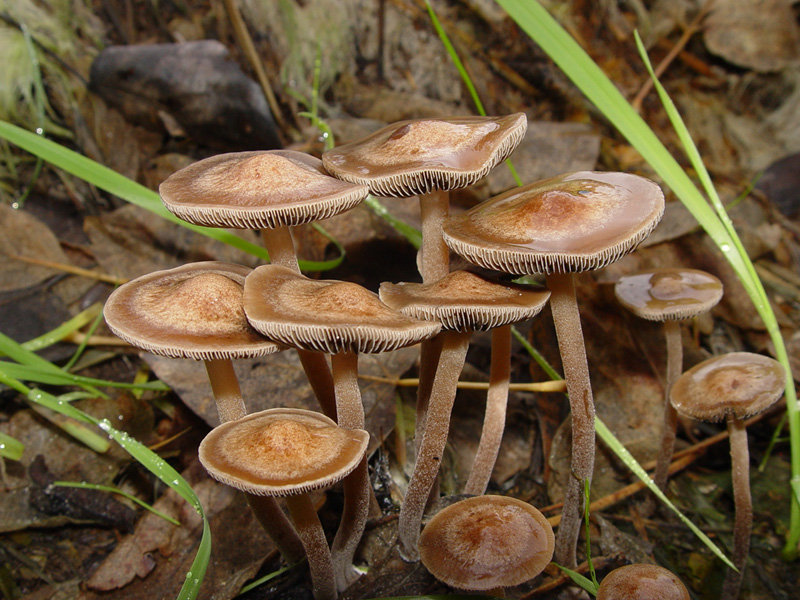- Panaeolus cinctulus
Taxobox
name = "Panaeolus cinctulus"

image_width = 250px
regnum =Fungi
phylum =Basidiomycota
classis =Hymenomycetes
ordo =Agaricales
familia =Bolbitiaceae
genus = "Panaeolus "
species = "P. cinctulus"
binomial = "Panaeolus cinctulus"
binomial_authority = (Berkeley & Broome) Saccardo
synonyms = "Panaeolus subbalteatus"mycomorphbox
name = Panaeolus cinctulus
whichGills = adnate
whichGills2 = adnexed
capShape = convex
hymeniumType=gills
stipeCharacter=bare
ecologicalType=saprotrophic
sporePrintColor=black
howEdible=psychoactive"Panaeolus cinctulus", also known as "Panaeolus subbalteatus" is a very common, widely-distributed
psilocybin mushroom . The mushroom is a (dung-inhabiting) species that also grows well in otherhabitat s including fertilized lawns, haystacks, compost heaps and riding stables. It grows abundantly year round after rain and is common in Oregon, Washington and Northern California, but is also known to occur in all 50 states, Great Britain, Europe, Russia, Asia, Australia, Mexico, Central and South America and British Columbia. According toDavid Arora , "Panaeolus cinctulus" is the most commonpsilocybin mushroom in California.During the early part of the 20th century this species was often referred to as the "weed Panaeolus" because it was a common occurrence in beds of the commercially grown grocery store mushroom "
Agaricus bisporus ". Because of its intoxicating properties the mushroom farmers had to weed it out from the edible mushrooms. [Singer and Smith (1958)]Although not specifically scheduled in the United States,
psilocybin containing mushrooms are considered "containers" of a scheduled substance, and their usage and possession is illegal in most states.Description
*Cap: (1.5)2 to 5(5.5) cm, convex to broadly umbonate or plane in age. Surface smooth, hygrophanous, reddish brown when moist, fading to buff as it dries. Often with a darker band along the margin which disappears as the mushroom completely dries out. The flesh is brown and thin.
*Gills: Close, adnate to adnexed, brownish at first, mottled, turning black as the spores mature, gill edges white and slightly fringed.
*Spores: Jet Black, 12 x 8 micrometres, smooth, elliptical.
*Stipe: (2)3.5 to 8(10) cm long, 3 to 9 mm thick, equal or tapered at the ends, reddish brown to whitish, pruinose, often with gray spore dust, hollow, no veil remnants, marked with short white fibrils, striate at the apex or vertically down the entire length of the stipe. Stem base and mycelium occasionally staining blue.
*Taste: Farinaceous when fresh, saliferous (salty) when dried.
*Odor: Mushroomy.
*Microscopic features:External links
* Guide to Hunting and Identifying Panaeolus subbalteatus [http://www.shroomery.org/9608/Subbedhunter420s-Guide-to-Hunting-and-Identifying-Panaeolus-Subbalteatus]
* Close Encounters of the Panaeolus Kind [http://www.shroomery.org/6239/Close-Encounters-of-the-Panaeolus-Kind]
* Indoor and Outdoor cultivation of Panaeolus subbalteatus [http://www.erowid.org/plants/mushrooms/mushrooms_cultivation24.shtml]
* Lycaeum LEDA - Panaeolus subbalteatus [http://leda.lycaeum.org/?ID=6693]
* [http://www.museocivico.rovereto.tn.it/UploadDocs/104_art09-Guzman%20&%20C.pdf A Worldwide Geographical Distribution of the Neurotropic Fungi]References
Wikimedia Foundation. 2010.
